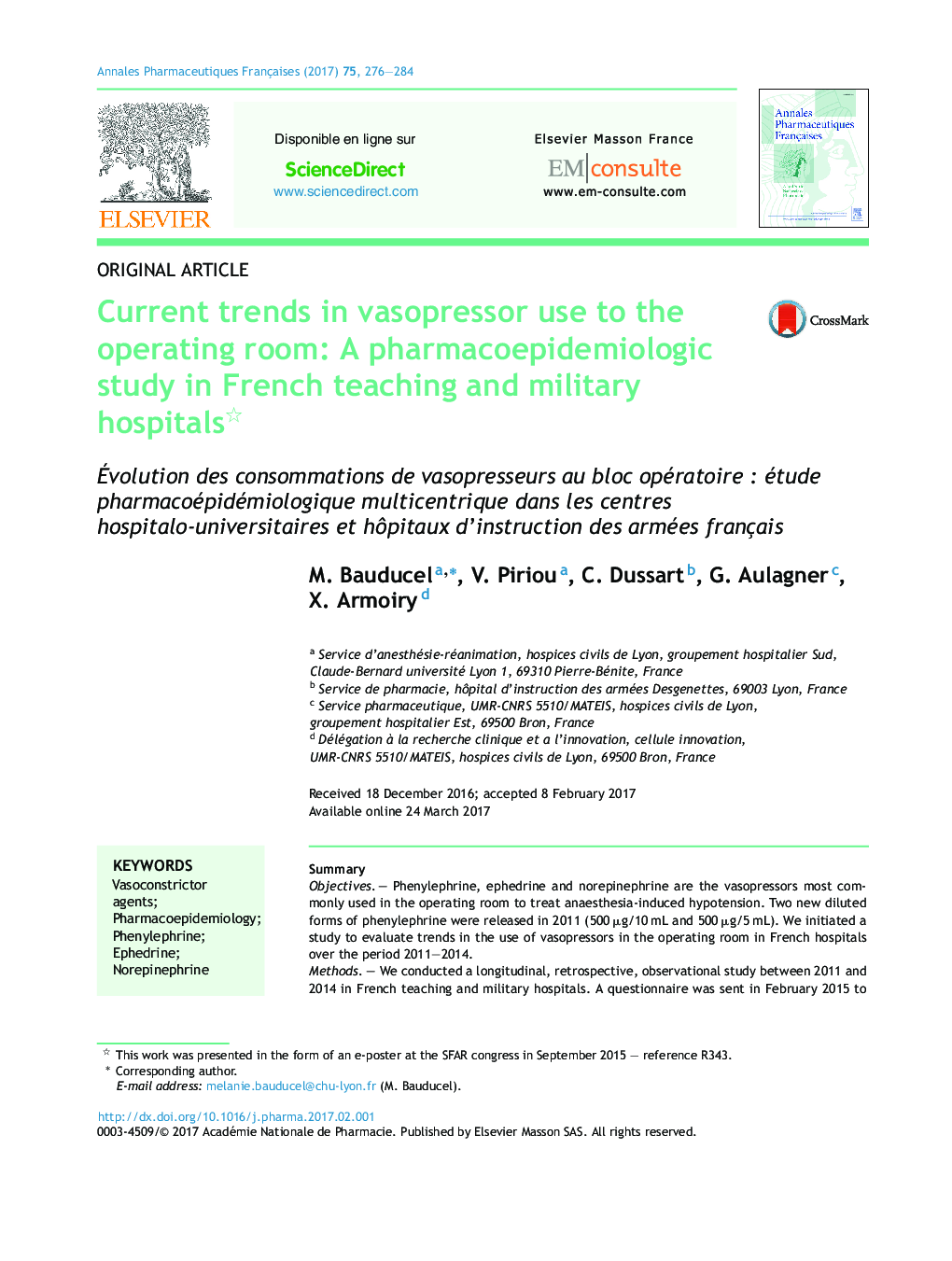| کد مقاله | کد نشریه | سال انتشار | مقاله انگلیسی | نسخه تمام متن |
|---|---|---|---|---|
| 5546988 | 1402774 | 2017 | 9 صفحه PDF | دانلود رایگان |
SummaryObjectivesPhenylephrine, ephedrine and norepinephrine are the vasopressors most commonly used in the operating room to treat anaesthesia-induced hypotension. Two new diluted forms of phenylephrine were released in 2011 (500 μg/10 mL and 500 μg/5 mL). We initiated a study to evaluate trends in the use of vasopressors in the operating room in French hospitals over the period 2011-2014.MethodsWe conducted a longitudinal, retrospective, observational study between 2011 and 2014 in French teaching and military hospitals. A questionnaire was sent in February 2015 to hospital pharmacists of each centre to retrospectively collect the consumption of each type of vasopressor. Yearly numbers of vasopressor ampoules were divided by the yearly numbers of anaesthetics recorded. For each vasopressor, we calculated the number of ampoules per 100 anaesthetics recorded (/100A).ResultsThirty-two hospitals (82%) completed the questionnaire. One hundred per cent of hospitals had registered the diluted form of phenylephrine (61% had chosen the dilution 500 μg/10 mL), whereas concentrated ampoules were available in 68% of hospitals. Over the period, an exponential increase in the use of diluted phenylephrine was observed (from 1.0 ampoule/100A in 2012 to 31.7 in 2014), the use of ephedrine remained stable (26 ampoules and 17 prefilled syringe/100A), and use of norepinephrine trended upwards (from 6.7 to 8.2 ampoules/100A).ConclusionsThe use of diluted phenylephrine has exponentially increased without reducing consumption of other vasopressors. This trend might be secondary to practice changes in hypotension treatment following the release of French guidelines in 2013 related to fluid management, the restriction of indications of hydroxylethyl-starch solutions in 2013, and a better knowledge of the benefit of blood pressure optimisation to reduce postoperative morbidity.
RésuméObjectifsL'éphédrine, la phényléphrine et la noradrénaline sont des agents vasopresseurs couramment utilisés au bloc opératoire pour traiter les hypotensions. Suite au référencement de la PHE diluée (50 ou 100 μg/mL) en 2011, nous avons initié cette étude afin d'évaluer l'utilisation des agents vasopresseurs au sein des centres hospitalo-universitaires et des hôpitaux d'instructions des armées français sur la période 2011-2014.MéthodesNous avons réalisé une étude observationnelle, rétrospective, longitudinale entre 2011 et 2014 dans les hôpitaux français. Un questionnaire a été adressé en février 2015 aux pharmaciens de chaque établissement pour collecter la consommation annuelle de chaque vasopresseur. Le nombre d'ampoules annuellement consommées était divisé par le nombre annuel d'anesthésies. Pour chaque vasopresseur, nous avons calculé le nombre d'ampoules consommées pour 100 anesthésies (/100A).RésultatsTrente-deux hôpitaux (82 %) ont répondu à notre enquête. Cent pour cent des hôpitaux ont référencé la phényléphrine sous forme diluée, alors que 68 % utilisaient la forme concentrée. Au cours de la période, une consommation exponentielle de phényléphrine diluée est observée (de 1,0 ampoule/100A en 2012 à 31,7 en 2014). La consommation d'éphédrine est stable (26 ampoules et 17 seringues pré-remplies/100A), et la consommation de noradrénaline augmente légèrement (de 6,7 à 8,2 ampoules/100A).ConclusionsLa consommation de phényléphrine diluée est exponentielle sans réduire la consommation des autres vasopresseurs. Cette évolution peut s'expliquer par les recommandations de la Société française d'anesthésie-réanimation sur le remplissage vasculaire, la restriction d'utilisation des hydroxyéthylamidons depuis fin 2013 et la littérature récente sur les méfaits de l'hypotension artérielle peropératoire.
Journal: Annales Pharmaceutiques Françaises - Volume 75, Issue 4, July 2017, Pages 276-284
